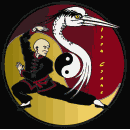|
Learning the Tonfa
Tonfa, in one form or
another, have been around since the inception of martial
arts. In the modern world, they stand in the shadow of
other more portentous weapons. A typical Tonfa might be
a flat cut, or circular cut wood plank, about  24 inches in total length, with a handle projecting
perpendicular, several inches in from one of the ends.
Traditionally, these were solid, single piece units,
with the handle mounted/anchored through the plank, and
permanently fixed into position. They did not swivel,
nor were they mounted on washers to facilitate spinning
or rotation around the axis of the handle. Modern Tonfa
can be found with built in swivels, ball bearings, or
free spinning handles, facilitating rotational moves. I
prefer traditional units. They manipulate and maneuver
just fine, without the add ons (all of the accompanying
video was shot using traditional weapons...free of
tricks or gimmicks).
24 inches in total length, with a handle projecting
perpendicular, several inches in from one of the ends.
Traditionally, these were solid, single piece units,
with the handle mounted/anchored through the plank, and
permanently fixed into position. They did not swivel,
nor were they mounted on washers to facilitate spinning
or rotation around the axis of the handle. Modern Tonfa
can be found with built in swivels, ball bearings, or
free spinning handles, facilitating rotational moves. I
prefer traditional units. They manipulate and maneuver
just fine, without the add ons (all of the accompanying
video was shot using traditional weapons...free of
tricks or gimmicks).
Several decades ago, Tonfa almost passed
from the modern scene. With the explosion of interest in
martial arts during the 1960's, Law enforcement agencies
noted the tactical superiority of Tonfa over the
prevalent police baton. Since then, they have become
very popular with law enforcement, and are known
variously as Police Tonfa, side-handle batons, TR-24's,
PR-24's, etc,
This is not surprising, as Tonfa were
frequently the weapon of choice for medieval Japanese
police officers, and for good reason. With relatively
little training, an individual could develop an arsenal
of bone breaking blocks, strikes and counters,
effectively establishing tactical superiority over the
unarmed, or lightly armed opponent. At higher levels of
execution, Tonfa proved to be effective even against the
sword wielding samurai.
In the arts, two are used
simultaneously (one in each hand), which allows for full
movement of the body, and use of feet as appropriate
(generally I prefer sweeps and balance attacks over
kicks). Because of the physical properties of the side
handle configuration, tremendous rotational velocity can
be developed in even the tightest of spaces (not unlike
the rotational characteristics of nunchaku). Twin Tonfa
can be rotated and spun like Arnis middle sticks, and in
fact, many Arnis drills and techniques can be executed
with Tonfa, after only minor adjustments. They can be
used as thrusting weapons, and fit perfectly into the
postures and stances supporting traditional (hard style)
low, high and mid blocks. If that’s not enough, a little
creative improvisation reveals that gripping the trunk
of the Tonfa permits using the handle as a striking
element, much like a hammer. Or, with an additional
sprinkle of improvisation, the trunk held Tonfa begins
to act like a cane or extended hook, opening up a world
of pull downs, joint locks and control techniques.
Black Belts will invest approximately
12-18 months of hard work in becoming excellent with the
Tonfa. Most law enforcement personnel undergo a much
truncated basic training regimen. They are not Tonfa
experts, they carry only a single unit, and use it with
one hand free. This facilitates control options crucial
to law enforcement, but limits the tactical array
available with two Tonfa. Regardless, Tonfa, even as a
solitary unit, has proven its value in non lethal police
applications.
At Iron Crane, we teach Tonfa to
advanced students, typically after they have experienced
middle stick fighting (Arnis), knife defense, and Bo. By
the time students pick up Tonfa, the basic instincts,
stances and footwork are in place. The student is first
introduced to the basic moves, then becomes proficient
with combinations of the basics (we have compiled some
basic moves and archetypical combinations in the
accompanying video clips (Drills 1 & 2)). Once
students can move the weapons with confidence, they
learn Kata. Each Kata is progressively more complex.
So...over the course of training, you acquire the moves,
explore the nuances, perfect them, and then solidify the
knowledge with a crowning Kata. Kata #1 addresses the
basic pattern off of a down block, introduces double
blocks, and multiple strikes. Kata #2 goes to the next
level, emphasizing the down block/high block sequence,
followed by the basic strike pattern. The middle
sections close with transitional cross body swings. Both
forms are modeled on Shotokan’s Taikyoku forms. Katas 3;
4 (Tonfa Tiifa); and 5 (Hama Higa) represent Black Belt
level concepts. Each embodies a unique array of skills,
angles and techniques. Tonfa Tiifa is widely popular
with West Coast Isshinryu proponents. Hama Higa (named
after the Okinawan Island, probably where it originated)
is also taught at Isshinryu schools, but is equally
popular with virtually all Okinawan derivative systems.
Kata #3 was created at the Iron Crane Dojo, essentially
as a final repository for techniques not preserved in
the other forms.
Here they are, for your viewing
pleasure...
|
Tonfa
Drills #1
|
|
|
|
Tonfa
Drills #2
|
|
|
|
Tonfa
Form #1 (Front and Side Views)
|
|
|
|
Tonfa
Form #2 (Front and Side Views)
|
|
|
|
Tonfa
Form #3 (Front and Side Views)
|
|
|
|
Tonfa
Form #4 - Tonfa Tiifa
(Front and Side Views)
|
|
|
|
Tonfa
Form #4 - Hama Higa
(Front and Side Views)
|
|
|
|
Shimabuku
Tonfa
|
|
|
|
Shimabuku
(Bo/Tonfa Applications)
|
|
|
|


